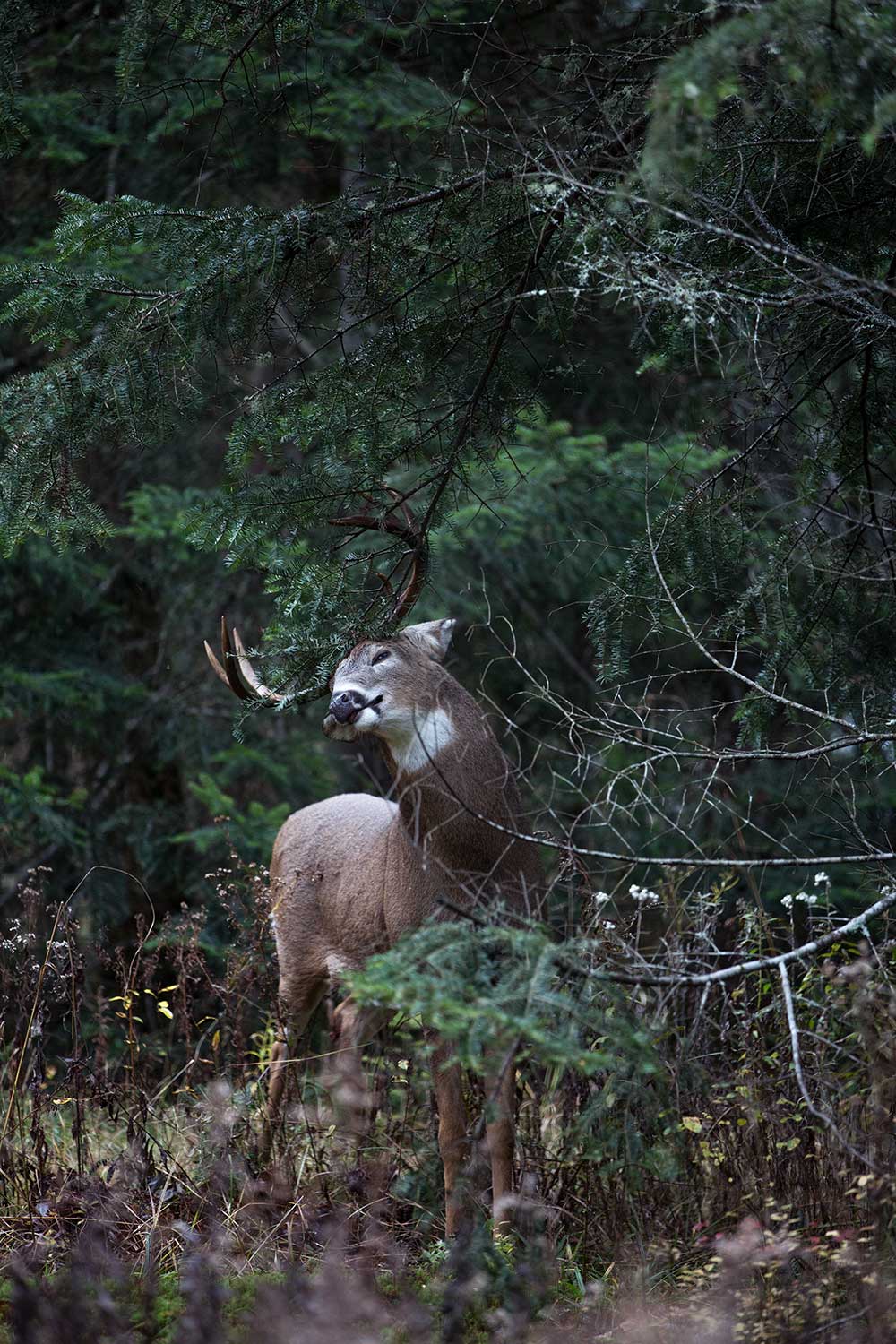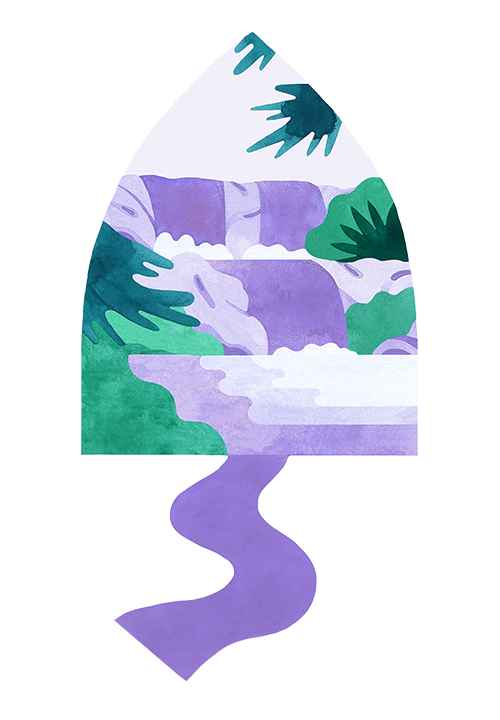Besiders
Life on the Mountain
Parc national du Mont-Tremblant is celebrating its 125th birthday. Behind the lush scenery, people are passionately working to preserve the land.
Text—Mélanie Gagné
Photos—Alexandra Côté-Durrer
Illustrations—Florence Rivest
In partnership with

It was once known as la Montagne Tremblante—the Trembling Mountain. According to a Weskarini Algonquin legend, this mountain—known to them as Manitonga Soutana—would shake whenever humans violated nature’s order. Today the mountain in the southern Laurentians and the land surrounding it are known—and protected—as Parc national du Mont-Tremblant.
And this year, we’re celebrating it: not just the park’s namesake mountain, but also the 400 mirrorlike lakes; the forests of maple, yellow birch, balsam fir, and blue-bead lilies; the six rivers running like ribbons between the many other mountains; and the waterfalls and sandy shores. Parc national du Mont-Tremblant is turning 125 years old.


The park over the ages
In 1894 Dr. Camille Laviolette envisioned a sanatorium on the mountain, where the ill—mainly tuberculosis patients—could enjoy the benefits of the clean air and landscape. Though the sanatorium never saw the light of day, le Parc de la Montagne-Tremblante was born on 12 January 1895.
From 1895 to 1961 logging represented the park’s major economic activity. At first, the area’s thick pines and spruce were sought to meet the United States’ lumber needs. At the beginning of the 20th century, pulp production took over and the park’s waterways became paths for transporting wood to factories and sawmills.
Private clubs held hunting and fishing privileges and took advantage of the park’s abundant fauna.
In 1930 nature lobby groups began to call for the park to be dedicated to conservation.
Recreation on the mountain soon began to grow. Norwegian skier Herman Smith-Johannsen, better known as Jackrabbit, explored the Devil’s Valley in the late 1920s and would quickly lay the groundwork for the first ski slopes. In 1958 the park was opened to the public for the first time. Visitors began coming to camp at Lac Chat, and the range of outdoor activities in the park improved.
In 1977 Québec passed the Parks Act, which prohibited hunting and natural resource exploitation in parks. Four years later the former forest reserve was granted park status and became Parc national du Mont-Tremblant. In 1999 the Société des Établissements de Plein Air du Québec (Sépaq) took over park management.
Not long after that, Mont-Tremblant was designated a national park in Québec, with conservation as its core mission. Since then, work has been done to restore its shorelines, which serve as breeding, feeding, and nesting grounds for a number of animal species.
Today, people visit this vast outdoor playground to hike, ski, cycle, camp, or explore the water by kayak, canoe, or even rabaska. Others simply come to enjoy a stay in a chalet surrounded by nature.

***
Suzanne Coutu, Stéphane Decelles, and Éric Normandeau are employees of Parc national du Mont-Tremblant, which has a staff of about 169 in the summer and 29 in winter. The lives of these three are all permanently interwoven with their bucolic work environment.

Suzanne
_____________
Suzanne Coutu came to the park at age 17. She planned to work there temporarily during her studies, but she never left. Now she’s a customer service coordinator for two of the park’s sectors, Pimbina and Assomption.
“My whole life is tied to the park! I’m so attached to it. I’ve lived through so much here, including my two pregnancies.”
She has now been working for the park for 45 years. “When I started, nature wasn’t as well protected; there were fewer regulations. You could camp anywhere. People were overfishing. I’ve watched things change for the better. Now, it’s controlled and protected. There aren’t quite as many campsites, and there are areas where people can’t go.”
Her passion for nature is clearly apparent to her staff and park visitors: “People often say, ‘Gosh, you seem to really love your job! You’re always in a good mood!’” And does she ever think about retiring? Laughing, she replies, “You’d have to force me to leave!”
Suzanne particularly likes the trail that leads to the Chute-aux-Rats waterfall. She fondly remembers her parents taking her there for picnics when she was little.

Stéphane
_____________
Stéphane Decelles has been a public service attendant in the park since he was 18; he is now 51. But his ties to the park go back even further: “My family comes from Montréal, so I spent my summer vacations here.”
It would be an understatement to say that the Decelles family history is intimately bound to Parc national du Mont-Tremblant. “My mother, my father, my brother, and one of my sisters also worked here. My father was a park ranger. He’s my hero. He passed on his love of nature, animals, and the arts to me,” says Stéphane.
He does maintenance work, paints, cleans the grounds, and mows the grass: “I’m never stuck indoors. That’s what I like about it; I’m free.” Stéphane often has his camera on hand in case he spots any animals. In his spare time, he paints: he’s responsible for the mural of a large wolf face—the symbol of the park—in the employee kitchen.

Éric
_____________
Éric Normandeau is 47 years old and has worked in the park for the past 25 years, as a park ranger in the winter and a warden and nature interpreter in the summer.
“I often joke, ‘Check out my office: there’s no burning out here!’ It’s beautiful: 1,510 km2 of nature, 400 lakes, mountains, and forest as far as the eye can see.”
Éric notes that in its early days, the park’s clientele were typically Quebecers. “Now, with the Mont-Tremblant Resort, the clientele is much more international. They’re mainly Europeans, people who dream of the Québec and Canadian landscape. When they meet a nature interpreter, they have questions. They’re fascinated.”
Éric teaches visitors about wolves and black bears, along with several other animals. “Wolves are amazing predators. They’re so mysterious! Some people are very afraid, and others ask to see one, as if it were a domesticated animal. You rarely see wolves, because they’re nocturnal and wild, but you can see footprints, dung, and the carcasses they leave behind.” According to Éric, you can also detect the presence of marten, otter, fisher, and mink, and you can hear loons calling.
During his first years in the park, Éric even spent all of his vacations there, by choice. “My favourite spot is the Lac des Cyprès, the largest lake in the park, which I explored by sea kayak. It’s a very wild place. There are enormous bays with aquatic meadows stretching as far as the eye can see. When the meadow is flowering, it’s magic.”

The Société des Établissements de Plein Air du Québec (Sépaq) develops and ensures the sustainability of the land and public assets entrusted to it, for the benefit of its clientele, the province’s administrative regions, and future generations.
Parc national du Mont-Tremblant was the first park in Québec’s national park network, which has been managed by Sépaq since 1999. Today, Sépaq has 23 national parks in addition to the Saguenay–Saint-Lawrence Marine Park, which it manages jointly with the federal government, totalling 7,017 km2 [4,360 square miles] of unique protected areas all across the province.
Mélanie Gagné is a content creator and teacher in Matane. The St. Lawrence River has been part of her life since childhood, and continues to amaze, calm, and inspire her. She enjoys living in the countryside with her family and hiking along the river or in the mountains, as well as public markets, poetry, and cafés.